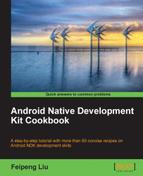The previous two recipes discussed how to port a library with the
Android NDK build system. However, a lot of open source projects have their own build systems and sometimes it is troublesome to list out all sources in the Android.mk file. Fortunately, the Android NDK toolchain can also be used as a standalone cross compiler and we can use the cross compiler in an open source project's existing build system. This recipe will discuss how to port a library with its existing build system.
The following steps describe how to create our sample project, which demonstrates porting the open source libbmp library with its existing build system:
- Create an Android application named PortingWithBuildSystem with native support. Set the package name as
cookbook.chapter8.portingwithbuildsystem. Please refer to the Loading native libraries and registering native methods recipe of Chapter 2, Java Native Interface, if you want more detailed instructions. - Add a Java file
MainActivity.javaunder thecookbook.chapter8.portingwithbuildsystempackage. This Java file simply loads the shared libraryPortingWithBuildSystem, and calls the native methodnaCreateABmp. - Download the
libbmplibrary from http://code.google.com/p/libbmp/downloads/list and extract the archive file to thejnifolder. This will create a folderlibbmp-0.1.3under thejnifolder with the following content:
- Follow step 3 of the Porting a library as shared library module with Android NDK build system recipe to update
src/bmpfile.h. - Add a bash shell script file
build_android.shunder thelibbmp-0.1.3folder with the following content:#!/bin/bash NDK=<path to Android ndk folder>/android-ndk-r8b SYSROOT=$NDK/platforms/android-8/arch-arm/ CFLAGS="-mthumb" LDFLAGS="-Wl,--fix-cortex-a8" export CC="$NDK/toolchains/arm-linux-androideabi-4.4.3/prebuilt/linux-x86/bin/arm-linux-androideabi-gcc --sysroot=$SYSROOT" ./configure --host=arm-linux-androideabi --disable-shared --prefix=$(pwd) --exec-prefix=$(pwd) make clean make make install
- Add the execute permission to the
build_android.shfile with the following command:$ sudo chmod +x build_android.sh
- At a command line shell, go to the
libbmp-0.1.3directory, and enter the following command to build the library:$ ./build_android.sh
The build will fail with the following errors:

This is because the
config.guessandconfig.subscripts under thelibbmp-0.1.3folder are out of date (the first line of these two files indicate that the timestamp is2009-08-19). We will need copies of the scripts with timestamps2010-05-20or later. Theconfig.guessscript can be found at http://gcc.gnu.org/svn/gcc/branches/cilkplus/config.guess andconfig.subcan be found at http://gcc.gnu.org/svn/gcc/branches/cilkplus/config.sub. - Try executing the
build_android.shscript again. This time it finishes successfully. We should be able to find thelibbmp.astatic library under thejni/libbmp-0.1.3/libfolder andbmpfile.hunder thejni/libbmp-0.1.3/includefolder.
Many of the existing open source libraries can be built with the shell command "./configure; make; make install". In our sample project, we wrote a build_android.sh script to execute the three steps with the Android NDK cross compiler.
The following are a list of things we should consider when porting a library with the Android NDK cross compiler:
- Select the appropriate toolchain: Based on the CPU architecture (ARM, x86 or MIPS) of our targeted devices, you need to choose the corresponding toolchain. The following toolchains are available under the
toolchainsfolder of Android NDK r8d:- For ARM-based devices:
arm-linux-androideabi-4.4.3,arm-linux-androideabi-4.6,arm-linux-androideabi-4.7, andarm-linux-androideabi-clang3.1 - For MIPS-based devices:
mipsel-linux-android-4.4.3,mipsel-linux-android-4.6,mipsel-linux-android-4.7, andmipsel-linux-android-clang3.1 - For x86-based devices:
x86-4.4.3,x86-4.6,x86-4.7, andx86-clang3.1
- For ARM-based devices:
- Select the sysroot: Based on the Android native API level and CPU architecture we want to target, you will need to choose the appropriate sysroot. The compiler will look for headers and libraries under the
sysrootdirectory at compilation.The path to
sysrootfollows this format:$NDK/platforms/android-<level>/arch-<arch>/
$NDKrefers to the Android NDK root folder,<level>refers to the Android API level, and<arch>indicates the CPU architecture. In yourbuild_android.shscript,SYSROOTis defined as follows:SYSROOT=$NDK/platforms/android-8/arch-arm/
- Specify the cross compiler: The library's existing build system usually has a way for us to specify the cross compiler. It is usually through a configuration option or an environment variable.
In
libbmp, we can enter the "./configure --help" command to see how to set the compiler. Thecompilercommand is specified through the environment variableCC, while the environment variablesCFLAGSandLDFLAGSare used to specify the compiler flags and linker flags. In yourbuild_android.shscript, these three environment variables are set as follows:export CFLAGS="-mthumb" export LDFLAGS="-Wl,--fix-cortex-a8" export CC="$NDK/toolchains/arm-linux-androideabi-4.4.3/prebuilt/linux-x86/bin/arm-linux-androideabi-gcc --sysroot=$SYSROOT"
- Specify the output locations for the header files and library binary: You will usually want to place the library under
jni/<library folder>/.In the case of
libbmp, the library binary is installed under thePREFIX/libfolder and the header file is installed under theEPREFIX/includefolder. Therefore, we setPREFIXandEPREFIXtojni/libbmp-0.1.3by passing the following options to configure the script:--prefix=$(pwd) --exec-prefix=$(pwd)
- Make and install the library: You can simply execute "
make; make install;" to build and install the library.
In your build_android.sh script, we have disabled shared library. If you remove the line "--disable-shared ", the build will generate both the shared library (libbmp.so) and the static library (libbmp.a) under the jni/libbmp-0.1.3/lib/ folder.
In your sample project, we used the NDK toolchain directly. This method has a serious limitation that you won't be able to use any C++ STL function, and C++ exceptions and RTTI are not supported. Android NDK actually allows you to create a customized toolchain installation with the script $NDK/build/tools/make-standalone-toolchain.sh. Suppose you're targeting Android API level 8; you can use the following command to install the toolchain at the /tmp/my-android-toolchain folder.
$ANDROID_NDK/build/tools/make-standalone-toolchain.sh --platform=android-8 --install-dir=/tmp/my-android-toolchain
You can then use this toolchain by using the following commands:
export PATH=/tmp/my-android-toolchain/bin:$PATH export CC=arm-linux-androideabi-gcc
Note that the installed toolchain will have a
few libraries (libgnustl_shared.so, libstdc++.a, and libsupc++.a) under the /tmp/my-android-toolchain/arm-linux-androideabi/lib/ folder. You can link against these libraries to enable exceptions, RTTI, and STL functions support. We will further discuss exception and STL support in the Porting a library which requires RTTI recipe.
More information about using the Android toolchain as a standalone compiler can be found at Android NDK in docs/STANDALONE-TOOLCHAIN.html.
